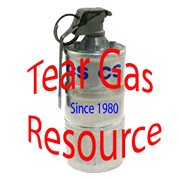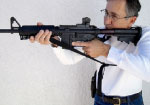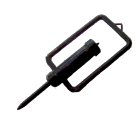There are four basic methods of delivery. That means that there are only four ways to get Non-Lethal Chemicals into the air and onto people. There are many variations of these four methods of delivery. Every manufacturer has their variation and usually a patent to protect it. These variations are how the manufacturers sell you their products. They always claim theirs as better than the competitors.
Pyrotechnic -the application of intense heat to granulated Non-Lethal Chemical Agent mixed with a pyrotechnic compound that vaporizes the agent and releases it as a submicron aerosol cloud. |
An example is the fuse safety pin. Most manufacturers use a time tested cotter pin through
the fuse and a bent over end to stop it from sliding out. A user has to straighten the cotter pin before they can remove the safety pin and deploy the grenade. Another manufacturer has changed the safety pin so that there is a clip that the safety pin ring locks into. That prevents the safety pin from sliding out. A user must unlatch the safety pin ring from the clip before deploying the grenade. Which method is better? Only you can decide.
The same theory applies to all the Non-Lethal Chemical Agent devices made today. There is a basic principal and many variations. Each method of delivery can be used in almost any situation. The user must decide which devices fits his style and train and use that device. When you see a device you should evaluate its method of delivery. Is it appropriate for your use in the tactics you are developing? If you understand how the device works that your department uses, you will be able to make a better gas plan and be safer when using chemical agent devices. When a salesman pitches a “new” device to you, you need to understand how it works, especially what it will do to the people and the places you are going to apply it. Is it safe and will it do its job?
Pyrotechnic, also called Burning or Continuous Discharge devices release an opaque cloud of white or gray smoke that carries vaporized agent as it re-condenses into submicron particles.
The advantages of this method of delivery are:
1. Continuous burning of the device allows longer persistence.
2. Can be projected from a launcher.
3. More accurate placement due to visible cloud.
4. Increased potential psychological effects due to visible cloud.
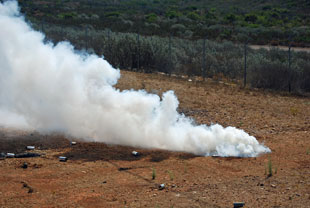
The disadvantages of this method of delivery are:
1. Can cause a fire if not properly deployed.
2. Can be picked up and thrown back at police lines.
3. When used indoors, a lethal concentration of agent may occur.
4. Burning cannot be stopped once device is activated.
Although burning time varies depending upon the amount of mixture, the munitions design, and the formulation involved, most commercial grenades release their content in from 15 seconds to 2.5 minutes. This release period allows rioters to take evasive action and perhaps kick the grenade canister away from their ranks or back towards police lines. While there have been reports from time to time of rioters picking up burning grenades and throwing them at police, this is not likely to occur. Commercial grenades become extremely hot after the first 25 seconds of ignition, necessitating the use of thick gloves or padding to handle the burning canisters.
Munitions manufacturers have responded to the threat of kickback or diversion of burning grenades in several ways. One grenade is divided into three individual sections that are separated from each other by expelling charges when the grenade is activated. The noise of the black powder expelling charges often unnerves rioters and the sudden separation of the grenade discourages returns, although the individual sections can be kicked about after the separation occurs. Another type of grenade burns and expels its entire fuel/agent mixture in a 10-second period, during which the rubber grenade body is constantly in motion.
Burning grenades produce a fire hazard when used in areas that contain combustible materials. In outdoor use, the major risk of fire arises in connection with spilled gasoline from overturned automobiles and dry grass or underbrush. Again, manufacturers have responded by developing grenades that remain relatively cool during burning and emit little or no flame. To minimize the return problem encountered with cooler munitions, the new, cool-burning grenades have generally been designed to remain in motion during combustion.
Expulsion, is also known as blast dispersion, explosive, bursting, expulsion dissemination or instantaneous discharge.
The advantages of this method are:
1. Immediate saturation of an area.
2. Inability to be thrown back.
3. Visible cloud allows for more accurate placement.
4. Almost no fire potential. 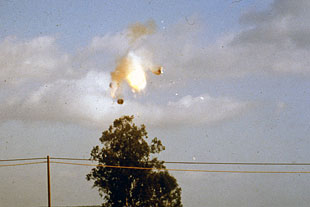
The Disadvantages of this method are:
1. Cannot be launched from a shotgun launcher.
2. Heavy contamination of the immediate area.
3. Heavy contamination when used indoors.
4. Weak persistence factor as it does not stay airborne very long.
All delivery methods that employ a force to expel and scatter a cloud of chemical agent can be called blast dispersion. All dissemination methods that employ a force to expel and scatter a cloud of chemical agent devices share a common characteristic in that they require an extremely fi ne agent formulation that will allow particles to remain airborne and drift with existing wind currents after being released from a container.
All these devices use an explosive force to propel the dry agent out of its canister and on to a target. To provide such a formulation, the chemical agent is micropulverized during the manufacturing process and either mixed with, or coated on, very fi ne carrier material such as silica aerogel or diatomite. The carrier material adds fluidity and helps to prevent the agent particles from caking together in the container prior to dispersal. In some cases, a synergistic carrier such as silicic anhydride is employed to produce a sneezing reaction that increases the total effect of the formulation. A mixture ratio of 5% carrier and 95% agent is employed in military munitions, but commercial products may range from a similar ratio down to a 50/50 mixture, depending upon the manufacturer.
Liquid Dissemination, includes those devices commonly called ferret rounds and hand-held aerosol devices (mace). The liquid dissemination method is also used in hand-held aerosol irritant projectors and in several bulk dispensers presently on the market. In both cases, a gas is used to propel the liquid agent formulation to a selected target area. When loaded in a hand-held canister, the system uses a non-toxic gas (ex. CO2) to propel a liquid agent to a selected target area. When loaded in a barricade penetrating projectile, it delivers a small amount of liquid formulation and releases it into the atmosphere at a very high speed. This enables the liquid to vaporize in the air and disperse with wind currents.
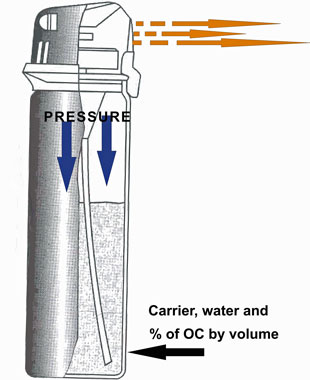 The advantages of this method are:
The advantages of this method are:
1. Non-fire starting.
2. Agent is invisible when deployed.
3. System can be deployed at close range (mace)
4. Portability.
5. Limited contamination.
6. More accurate deployment than other methods.
7. Can be used to expose single person or group.
The disadvantages of this method are:
1. Wind conditions can affect the deployment greatly.
2. Limited effectiveness.
3. Can injure more easily if improperly deployed (barricaded penetrating rounds).
4. Does not work on everyone (mace).
Fog Dissemination devices operate by rapidly vaporizing a high boiling-point liquid agent formulation. This is normally accomplished by injecting the liquid agent into a hot exhaust gas flow, allowing the vaporized agent to contact the cooler ambient air. This causes the agent to condense into a fog that contains extremely small agent particles. 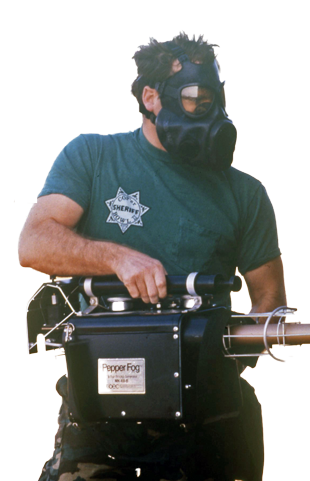
The advantages of this system are:
1. Economical to operate as compared to other methods. (The cost of agent is $.025 per gram compared to the cost of a burning grenade at $1.22 per gram of agent.)
2. Portability.
3. Increased potential psychological effects due to visible cloud.
4. More accurate placement due to visible cloud.
5. Agent flow can be started and stopped on demand by manual valve.
The disadvantages of this method are:
1. Potential for malfunction of mechanical device.
2. Officer utilizing the device is exposed.
3. Communications can be impaired due to extreme noise from device.
For much more information on this subject refer to chapter 3 of “Law Enforcement Chemical Agent Hand Book 2016”.
